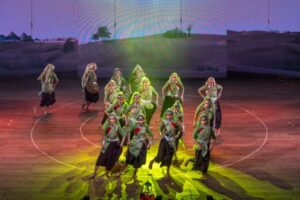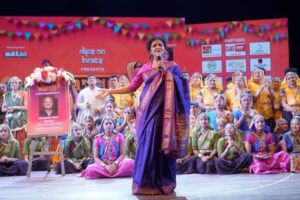Shila Mehta’s ‘Thangaat’ showcases the beautiful colours of Indian folk dances

Roots of any culture can be made strong only if their folk music and dance is given the right importance. Recently India celebrated, Garba being included in the prestigious list of the World Cultural Heritage. UNESCO inscribed the popular Gujarati folk dance Garba on its representative list of the ‘Intangible Cultural Heritage of Humanity’. Inclusion of Garba dance makes it India’s 15th inscription on the list includes Chhau Dance, Koodiyattam Dance, Mudiyettu Dance, Albelia Dance, Yoga, Kumbh Mela, Ram Lila, Vedic Chanting and more.
Renowned Kathak exponent Shila Mehta celebrated India like never before at her recent show titled Thangaat which travelled across different cities, excerpts from the interview:
How did the idea of a folk-dance event come to your mind?
The inception of the folk-dance event, is the product of my long association with choreography. It goes back to my formative years as a choreographer deeply entrenched in the realm of Raas Garba. As a teenager, in the vibrant city of Kolkata, West Bengal, I embarked on a journey to choreograph folk dances, particularly Raas Garba. My distinctive style was shaped not only through personal interpretation but also by immersing myself in the traditional styles of garba by visiting villages in Saurashtra and Gujarat, thus honing my craft and as a Gujarati by birth but, born and brought up in Kolkata, my upbringing was heavily influenced by two different worlds. In my early twenties, I orchestrated grand Raas Garba folk dance performances on various platforms all over Bengal.
I, relocated to Mumbai in 1997 and the thirst for creative spectacles remained palpable, only heightened by the pandemic year of 2020. During this challenging year, fate intervened tragically with the passing of Himanshu Dave, a cherished student and a talented artist, alongside two other devoted associates—Devesh Shah and Nilesh Joshi. In their memory, Himanshu Dave’s son, Nishant Dave, driven by a passion to rekindle my teachings and style, spearheaded the initiative to organize a program that would breathe life into the dance traditions once again. Supported by a team of my esteemed senior Garba students, known as the Nukkad team in Kolkata, the vision of Thangaat took flight.



How was Thangaat presented?
My immersion into the world of Kathak dance serves as the foundation for my venture into organizing Thangaat -a folk-dance extravaganza. The dance numbers presented encompassed a blend of tradition and innovation, while some pieces adhered closely to tradition, others were infused with a classic touch in their treatment. A Garba piece, written by the legendary Sri Avinash Vyas, was themed around a mirror. In this piece, Abhisaarika and Vaasaksajja Nayikas were in their Garba avataars, utilizing a mirror as a prop to create stunning visuals through meticulous use of Aaharya, including lighting, costumes, and backdrops.
Additionally, LED interactive technology was employed to enhance the traditional theme of selling butter by the Gopis, a common motif in both classical and folk-dance traditions.
The choice to, as a Kathak dancer, engage in the realm of folk dance stems from a deep appreciation of the richness and energy inherent in our folk traditions. While there are common themes shared between classical and folk traditions—such as Krishna, Devi, Ambe Maa, Gopi, Ganesha, and Shiva—the distinction lies in the execution or treatment. In folk, the focus is on the response to the beat, while in classical dance forms, the focus is on the saahitya (literary aspect). Both forms, however, are rooted in invoking divinity and embody devotional themes. Folk idioms, though not as multi-layered as classical idioms, are a powerful means to enhance the energy and grace of classical dance. Folk idioms aid in building physical energy and refining body grace, thereby complementing the intricacies of classical dance.



How important is the study of roots through folk danced in today’s times?
The famous Poet Bhartendu Harishchandra said Nij Bhasha Unatti Aahe, Sab Unatt Ko Mool, Bin Nij Bhasha Gyan Ke, Mitath Na Hiya Ko Sool (निज भाषा उन्नति अहै, सब उन्नति को मूल बिन निज भाषा-ज्ञान के, मिटत न हिय को सूल).
Means Developing one’s own language (Here with language I mean folk dances) is the key to every development, without knowledge of one’s own language, nothing can be lost.
Dance is an eternal expression inherent in all human beings. While some can effortlessly express it, others may have it hidden within. Various dances require learning specific skills, such as classical dances, while folk dances are natural expressions of the body through mundane hand and feet gestures that reflect the culture of a particular region or state. The accompanying songs are also in the regional language.
Dance involves expressing emotions and feelings through body movements and facial expressions, and language play a vital role in connecting to one’s roots. Different Indian communities connect deeply with dances rooted in their culture.
Expressing emotions and feelings through music, song and poetry often transcends what words alone can convey. These expressions hold immense psychological importance for human beings. This is where the significance of folk traditions comes into play. Classical dances necessitate dedicated learning and special skills, whereas folk traditions are deeply ingrained in the psyche of the people of that region, requiring less effort to embody.
Today’s generation is often disconnected from their mother tongue, given the scientific and practical dominance of English. However, it is important to know our mother tongue, our dance, music and culture as it is an important part of our identity. One needs to reconnect with their roots, and this is where the folk traditions of the region of birth step in.
Sandip Soparrkar holds a doctorate in world mythology folklore from Pacific University USA, an honorary doctorate in performing arts from the National American University, He is a World Book Record holder, a well-known Ballroom dancer and a Bollywood choreographer who has been honored with three National Excellence awards, one National Achievement Award and Dada Saheb Phalke award by the
Government of India. He can be contacted on sandipsoparrkar06@gmail.com





